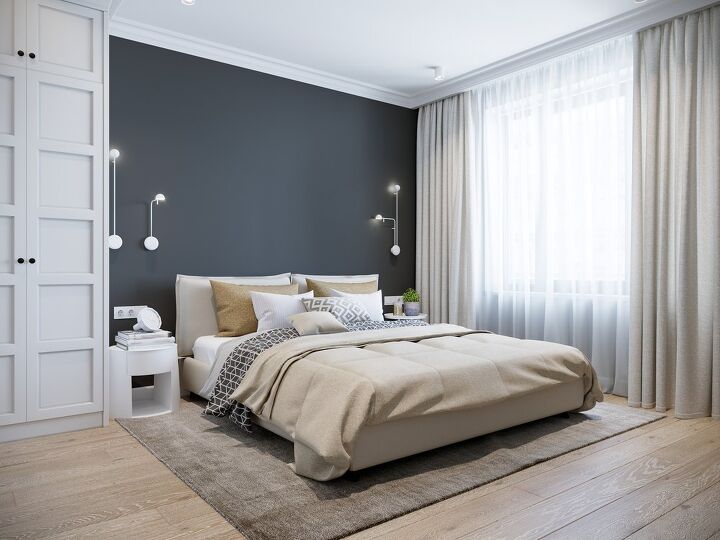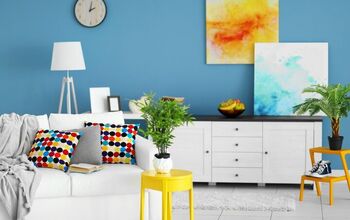Should You Have Light Or Dark Bedroom Furniture?

Homeowners put particular emphasis on the bedroom and the kitchen because they’re the most important room in a house. Setting the right tone in your bedroom can determine how comfortable you’ll be in the room you spend the most time in. So, should you have light or dark bedroom furniture?
Dark bedroom furniture is more dramatic than light furniture, but it isn’t ideal for small rooms with limited space. Small bedrooms can benefit from light furniture because it can make the space feel more open. Mix and match light and dark bedroom furniture to create a contrast for a dynamic aesthetic and to add depth to the room.
There is no ironclad rule when it comes to bedroom furniture color. It all depends on your taste and what you want to achieve with the tone of your bedroom. Follow along as we explore the differences between light and dark bedroom furniture and how to combine them.
Dark or Light Bedroom?
Choosing between dark and light bedroom furniture depends on your aesthetic and the size of the room. Light furniture can make a space feel more open when it is small, and that’s useful in a bedroom. Small bedrooms can feel cramped which can make it difficult to get comfortable for many homeowners.
Something as simple as a white or cream dresser can make your bedroom feel bigger. Dark furniture, on the other hand, is more dramatic and relaxing for many homeowners. Current trends in interior design point to dark bedroom furniture as the more popular modern choice.
Dark furniture won’t make your bedroom feel small by any means, but it doesn’t add depth as well as white does. There’s no reason to limit yourself to one particular color scheme for your bedroom furniture. Combining light and dark furniture can contribute to a more dynamic and comfortable bedroom.
Can You Mix Brown And White Bedroom Furniture?
Brown and white bedroom furniture go together and create a dynamic contrast. You can even add white hardware to brown bedroom furniture to create a contrast within one piece. Otherwise, a brown bench or chest at the foot of a mostly white bed is enough for a bold contrast.
It’s all about placement and the overall tone you want to achieve for the room. Brown and white are distinctly different, but pairing them can bring out different tones in each color. Splashes of white furniture or décor can help brighten up a dark room with lots of browns.
Not only is white lighter than brown, but it’s also more reflective. You can mix brown and white bedroom furniture to create a contrast and a more unique lighting situation. This can let you keep the lighting dim without losing visibility amongst the dark furniture.
Mixing Dark And Light Bedroom Furniture
You can’t go wrong mixing dark and light bedroom furniture as long as you stick to certain guidelines. Pick a specific piece of bedroom furniture that you want the rest of the room to compliment. Common bedroom centerpieces include beds, chests, and dressers.
Do you want your centerpiece to blend in or contrast the other furniture and décor? For example, you may want your central piece of bedroom furniture to be lighter than the surrounding décor so it stands out more. Light and dark bedroom furniture will always contrast one another and make the room more dynamic.
There has to be some rhyme or reason or else the furniture will clash. A dark dresser with light hardware will look great in the same space as a dark bed with a light-colored duvet, for example. Two-toned furniture with light and dark shades also looks great in the bedroom, especially as a nightstand.
What Colors go With Dark Wood Bedroom Furniture?
Dark wood bedroom furniture is dramatic and can make a bedroom feel private and comfortable. It is natural to want to brighten the space up and pair it with another color. A color like blue-gray can contrast and brighten dark wood bedroom furniture subtly.
Brighter colors like yellow can contrast dark wood bedroom furniture, but it can be a risky combination. Touches of yellow can stand out perfectly against your dark furniture. A yellow throw pillow, blanket, piece of art, or trinket goes perfectly with dark wood in small doses.
Classic neutral colors like slate gray go well with dark wood bedroom furniture because it isn’t disruptive. Vibrant colors like yellow or forest green go well with dark wood furniture, but you don’t want to overdo it. The last thing you want is to take away from your dark bedroom furniture with an over-the-top color like pink or red.
Does Dark Wood Furniture Make a Room Smaller?
Dark wood furniture can make a room feel smaller with the wrong lighting. Too much dark furniture has a limited ability to reflect light which can make the space feel even darker. Excessive darkness makes it seem like there is too much negative space in the room.
Dynamic lighting, bright décor, and colorful accents throughout the room can mitigate this problem. Dark furniture doesn’t make a room feel small by default, but a lack of balance certainly does. A bedroom filled exclusively with dark furniture, walls, bedding, and flooring will generally feel small.
You can mitigate this problem if you add simple touches such as a white or cream-colored rug. Bright art, pillowcases, sheets, and bedding can add enough light to a dark room to make it feel less cramped.
What Color Furniture Makes Room Bigger?
White and blue are the most popular furniture colors that make a room feel bigger. Some shades of green, such as Kelly green and forest green can also make a space feel open. Cool shades of gray with blue tones contribute to a more open aesthetic.
You can pair blue, white, or green furniture with dark furniture and flooring for a great effect. This will allow you to retain the dark tones without making your bedroom feel cramped. Even navy blue can add a sense of depth to a room, but it doesn’t pair well with black or dark brown.
Relaxing Bedroom Furniture Colors
The most relaxing bedroom furniture colors include pastel purple, baby blue, white, and dusty pink. Each of these colors varies in appearance but all have a similar vibe. Soft pastels add color and character to your room without stimulating the brain too much.
Dusty pink may be relaxing, but hot pink would be too mentally stimulating for bedroom furniture. It may sound counter-intuitive, but red bedroom furniture can be quite relaxing at night as well. Red can naturally help you fall asleep because it doesn’t negatively affect your melatonin production.
Cream bedroom furniture is also relaxing because of the soft yellow tones. Avoid shades of cream that are too bright, however, because bright yellow can increase alertness in the brain and make it hard to sleep. A combination of lavender, white, and blue furniture and décor will transform your bedroom into a much more tranquil space.
Summing it Up
Light bedroom furniture is the best option if you have a small room and want to make it feel better. Dark furniture is currently more popular however for its dramatic style and comfortable aesthetic. You can mix and match light and dark bedroom furniture if you carefully consider the combination.
Stick to a pattern and avoid jarring color combinations that would distract from your furniture. Dark bedroom furniture with light hardware is particularly popular. This allows for dynamics within a single piece that you can carry through to the rest of the room.
Colors like slate gray, blue-gray, yellow, and forest green all go well with dark furniture. Pick a piece of furniture like your bed or dresser that you want to compliment or contrast. Use this piece as a base for the color dynamics in the rest of the room so it all feels cohesive.
Related Guides

Nick Durante is a professional writer with a primary focus on home improvement. When he is not writing about home improvement or taking on projects around the house, he likes to read and create art. He is always looking towards the newest trends in home improvement.
More by Nick Durante












![The 10 Best Table Saws - [2022 Reviews & Buyer's Guide]](https://cdn-fastly.upgradedhome.com/media/2023/07/31/9070645/the-10-best-table-saws-2022-reviews-buyer-s-guide.jpg?size=350x220)












![Standard Dining Room Table Dimensions [for 4, 6, 8, 10 and 12 People]](https://cdn-fastly.upgradedhome.com/media/2023/07/31/9074335/standard-dining-room-table-dimensions-for-4-6-8-10-and-12-people.jpg?size=350x220)

